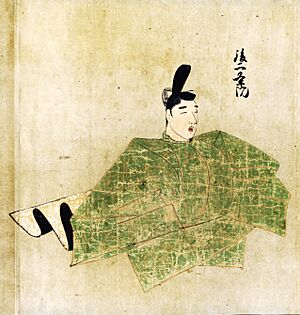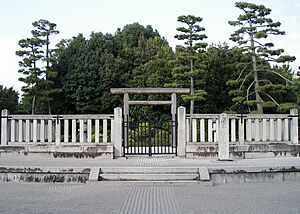Emperor Go-Nijō facts for kids
Quick facts for kids Emperor Go-Nijō後二条天皇 |
|||||
|---|---|---|---|---|---|
 |
|||||
| Emperor of Japan | |||||
| Reign | 2 March 1301 – 10 September 1308 | ||||
| Coronation | 3 May 1301 | ||||
| Predecessor | Go-Fushimi | ||||
| Successor | Hanazono | ||||
| Shōgun | Prince Hisaaki | ||||
| Born | 9 March 1285 | ||||
| Died | 10 September 1308 (aged 23) Heian-kyō, Kamakura shogunate |
||||
| Burial | Kitashirakawa no Misasagi (北白河陵) (Kyoto) | ||||
| Spouse |
Fujiwara no Kinshi
(m. 1303) |
||||
| Issue | See below | ||||
|
|||||
| House | Yamato | ||||
| Father | Emperor Go-Uda | ||||
| Mother | Horikawa (Minamoto) Motoko | ||||
| Religion | State Shinto | ||||
| Signature | |||||
Emperor Go-Nijō (後二条天皇, Go-Nijō-tennō, 9 March 1285 – 10 September 1308) was the 94th emperor of Japan. He ruled from 1301 until his death in 1308.
His name, Go-Nijō, means "Later Emperor Nijō." The word go- (後) means "later" or "second." This is because he was named after an earlier Emperor Nijō from the 12th century.
Becoming Emperor
Before he became emperor, his personal name was Kuniharu-shinnō (邦治親王).
Go-Nijō was the oldest son of the 91st emperor, Emperor Go-Uda. He belonged to a part of the Imperial Family called the Daikakuji-tō branch.
In 1286, when he was just a baby, Kuniharu-shinnō was officially made an imperial prince.
Later, in 1296, he became the crown prince. This meant he was chosen to be the next emperor. He was to take over from his second cousin, Emperor Go-Fushimi.
- 2 March 1301: Emperor Go-Fushimi had to give up his throne. Go-Nijō then officially became the new emperor.
During Go-Nijō's rule, his father, Emperor Go-Uda, acted as a cloistered emperor. This meant his father still had a lot of power and made important decisions, even though Go-Nijō was the official emperor.
There was a big disagreement in the Imperial Family about who should be emperor. This fight was between the Daikakuji and Jimyōin branches. Go-Nijō's grandfather, the retired Emperor Emperor Kameyama, helped him become emperor. He worked with the Bakufu, which was the military government at the time.
Family and Children
Emperor Go-Nijō had several children.
- Empress: Fujiwara no Kinshi (藤原忻子), also known as Chōrakumon-in. She was the daughter of Tokudaiji Kintaka.
- Naishi: Fujiwara Tamako (藤原 頊子), also known as Banshūmon-in (1268 - 1338). She was the daughter of Ichijō Sanetsune.
- Lady-in-waiting: Fujiwara Muneko (藤原 宗子), also known as Chunagon'no-tenji. She was the daughter of Itsutsuji Munechika.
- First Son: Imperial Prince Kuniyoshi (邦良親王; 1300 - 1326)
- Second Son: Imperial Prince Hanamachi-no-miya-Kunimi (花町宮邦省親王; 1302-1375)
- Naishi: Koto Naishi. She was the daughter of Taira Munetoshi.
- First Daughter: Imperial Princess Benshi (㛹子内親王; 1302 - 1362), also known as Jyuseimon'in/jyujoumon'in.
- Court Lady: Dainagon-no-tsubone (Fujiwara). She was the daughter of Sanjo Kinyasu.
- Third Son: Imperial Prince Priest Yujo (祐助法親王; 1302 - 1359)
- Fourth Son: Imperial Prince Priest Shoson (聖尊法親王; 1303 - 1370)
- Third Daughter: Imperial Princess Eiko (栄子内親王)
- Fifth Daughter
- Court Lady: Lady Mikushige (Fujiwara). She was from the Sanjo Kinchika family.
- Fifth Son: Imperial Prince Sonsai (尊済法親王; 1304 - 1329)
- Court Lady: Daughter of Taira Nobusuke.
- Fourth Daughter: Imperial Princess Choshi (瑒子内親王)
- Court Lady: Shindainagon-no-Tsubone.
- Second daughter: Imperial Princess Minshi (珉子内親王)
End of His Reign
Emperor Go-Nijō died from an illness on September 10, 1308.
He is buried at a place called Kitashirakawa no misasagi (北白河陵) in Sakyō-ku, Kyoto. This is his mausoleum, or burial place.
Eras During His Rule
In Japan, years are also counted using special era names called nengō. Here are the eras during Emperor Go-Nijō's reign:
See also
 In Spanish: Go-Nijō Tennō para niños
In Spanish: Go-Nijō Tennō para niños
- Emperor of Japan
- List of Emperors of Japan
- Imperial cult
| Regnal titles | ||
|---|---|---|
| Preceded by Emperor Go-Fushimi |
Emperor of Japan: Go-Nijō 1301–1308 |
Succeeded by Emperor Hanazono |


